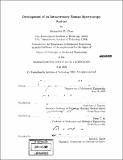Development of an intracoronary Raman spectroscopy
Author(s)
Chau, Alexandra H. (Alexandra Hung), 1980-
DownloadFull printable version (25.61Mb)
Other Contributors
Massachusetts Institute of Technology. Dept. of Mechanical Engineering.
Advisor
Guillermo J. Tearney and Peter T. So.
Terms of use
Metadata
Show full item recordAbstract
Atherosclerosis is a leading cause of death in the United States, with 1 in 5 deaths (500,000 annually) attributable to coronary artery disease alone. While the disease processes are not completely understood, it is believed that patient risk depends on a variety of factors including lesion structure, biomechanical behavior, and morphological and chemical composition. Raman spectroscopy, based on spectral analysis of inelastically scattered photons, is a nondestructive technique that yields detailed information about the chemical composition of the sample being interrogated. Intracoronary Raman spectroscopy can be performed via the use of a flexible, small diameter (< 2 mm) optical fiber probe to guide light to and from the arterial wall in situ. The fact that Raman scattering has inherently low signal intensity, combined with the need for a small diameter probe, makes it difficult to develop a probe with sufficient signal-to-noise for robust plaque diagnosis. This thesis addresses two approaches for increasing SNR: increasing Raman signal intensity and optimizing probe design. While most biological applications of Raman spectroscopy have been performed in the "fingerprint" region (Raman shifts between 400 and 1800 cm-1), the high wavenumber region (2700 - 3100 cm-1) offers distinct technical advantages, including increased Raman signal relative to the fluorescent background and potentially less fiber background. However, the high wavenumber region may yield different molecular information and thus have different diagnostic capability. In this thesis, we develop a benchtop Raman system capable of acquiring Raman spectra in both wavenumber regions. (cont.) In contrast to previous work, which focused on plaque characterization based on the Raman spectrum from a single site within the plaque, our system utilizes a line imaging paradigm, in which we acquire Raman spectra at fixed intervals across the full cross-section of the plaque, creating a Raman line image. We use this benchtop system to acquire a database of Raman line images and corresponding histology for over sixty plaque specimens. Using this database, we compare the diagnostic capability of fingerprint and high wavenumber Raman spectroscopy for plaque characterization. Because of the small size requirement for an intracoronary probe, it is important to optimize the optical probe design to maximize collection efficiency and thus increase SNR. We develop and experimentally validate a simulation technique for modeling Raman probe performance (collection efficiency and sampling volume), as an aid to optimizing probe design. We also fabricate a 1.5 mm diameter probe and demonstrate it in vivo, using a human-swine xenograft model, in which diseased human coronary arteries are grafted onto a living swine heart. The results of this thesis provide insight on two approaches toward achieving a clinically viable intracoronary Raman spectroscopy system.
Description
Thesis (Ph. D.)--Massachusetts Institute of Technology, Dept. of Mechanical Engineering, 2009. Includes bibliographical references (p. 167-177).
Date issued
2009Department
Massachusetts Institute of Technology. Department of Mechanical EngineeringPublisher
Massachusetts Institute of Technology
Keywords
Mechanical Engineering.